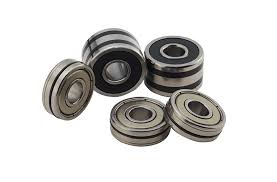Why Ballast Recycling Near Me Matters for the Environment
Why Ballast Recycling Near Me Matters for the Environment

Introduction to Ballast Recycling
Ballast recycling near me is an often overlooked but essential process that helps protect our environment from the detrimental effects of waste. Ballasts, which are used in lighting systems, contain components that can be harmful if not properly managed. They are found in a wide range of applications, from lighting in industrial settings to household devices. These devices help regulate electrical currents but, when they are no longer functional, become hazardous waste if not disposed of correctly.
In the modern world, where environmental concerns are at the forefront of global issues, the need for effective recycling methods cannot be overstated. Recycling ballasts prevents harmful substances from entering the environment, reduces waste in landfills, and promotes the recovery of valuable materials that can be reused in new products.
Environmental Impact of Ballast Waste
Improper disposal of ballast waste poses significant environmental challenges. Many ballasts contain polychlorinated biphenyls (PCBs), which are toxic and can persist in the environment for decades. When these materials are discarded into landfills or incinerated, they can release harmful chemicals into the air, water, and soil. This not only threatens local ecosystems but also endangers human health.
Ballast waste also contributes to the growing problem of landfill overuse. Landfills are rapidly reaching capacity, and the more waste we divert from them through recycling, the longer their lifespans will be.
The Ballast Recycling Process
The recycling process for ballasts is highly regulated to ensure the safe handling of hazardous materials. It involves several key stages:
- Collection and Transportation: Ballasts are collected from consumers and businesses and transported to specialized recycling facilities.
- Disassembly: The ballasts are dismantled to separate hazardous materials, such as PCBs, from recyclable components.
- Recycling: Metals and other recyclable materials are extracted and processed for reuse, while hazardous components are treated or disposed of safely.
This process not only minimizes environmental harm but also conserves resources by reclaiming valuable materials like copper, steel, and aluminum.
Benefits of Ballast Recycling for the Environment
Ballast recycling offers numerous environmental benefits. One of the most significant is the reduction of landfill use. By recycling ballasts, we divert waste from landfills, reducing the strain on these already overwhelmed sites. Additionally, the recycling process conserves natural resources by recovering materials that can be reused, reducing the need for virgin resource extraction.
Furthermore, recycling helps decrease the energy required for manufacturing new products. Reprocessing materials from recycled ballasts generally uses less energy compared to creating new materials from raw resources, which also helps reduce carbon emissions.
Why Recycling Locally is Important
Local recycling efforts play a critical role in reducing the environmental impact of waste management. When ballast recycling is done locally, it cuts down on the emissions generated by transporting waste long distances. Additionally, it supports local economies by creating jobs and reducing the need for extensive logistics operations.
Communities that prioritize local recycling also tend to have higher rates of participation in recycling programs, as people feel a greater connection to their environment and can see the direct benefits of their actions.
How Local Ballast Recycling Reduces Carbon Footprint
Recycling ballasts locally not only supports the environment but also plays a crucial role in reducing your carbon footprint. When waste is transported over long distances for recycling, the process consumes fuel, contributing to greenhouse gas emissions. By recycling ballasts at facilities closer to where the waste is generated, transportation emissions are minimized.
Local recycling centers tend to have more streamlined operations, which can result in quicker, more efficient processing of materials. This further reduces the energy and resources required, helping to lower the overall carbon footprint. The closer proximity also encourages more frequent recycling among residents and businesses, leading to a cumulative positive impact on the environment.
In contrast, international recycling efforts, while still valuable, often involve higher transportation costs, and the longer shipping routes contribute to greater carbon emissions. This makes local solutions not only environmentally friendly but economically viable.
Innovations in Ballast Recycling Technology
The technology behind ballast recycling is constantly evolving, driven by the increasing awareness of environmental sustainability and regulatory requirements. New innovations are helping to make the recycling process more efficient and cost-effective, while also reducing the potential risks associated with handling hazardous materials.
Some of the most recent advancements include:
- Automated Disassembly Systems: Automated machines are now capable of disassembling ballasts more efficiently, allowing for a faster and safer separation of hazardous materials from recyclable components.
- Advanced Metal Recovery: New techniques are emerging that improve the recovery of metals such as copper and aluminum from ballasts, maximizing the amount of recyclable material and reducing waste.
- Chemical Treatment of Hazardous Components: Innovations in chemical processing allow for safer treatment and neutralization of hazardous materials like PCBs, ensuring that they do not pose a risk to the environment during recycling.
These advancements are paving the way for a more sustainable future in ballast recycling, helping industries meet environmental regulations while minimizing the environmental impact of waste.
Common Challenges in Ballast Recycling
Despite the numerous benefits, ballast recycling faces a number of challenges that can impede its widespread adoption:
- Regulatory Hurdles: Many regions have strict regulations on the handling and disposal of hazardous materials found in ballasts. Compliance with these regulations can be complex and costly, especially for smaller recycling facilities.
- Hazardous Materials: The presence of toxic chemicals, like PCBs in older ballasts, requires careful handling. Facilities must invest in specialized equipment and trained personnel to manage these materials safely, which can increase operational costs.
- Lack of Awareness: Many consumers and businesses are not aware of the importance of recycling ballasts or how to properly dispose of them. Without adequate education, these items often end up in landfills, exacerbating environmental problems.
By addressing these challenges through better regulation, education, and investment in technology, ballast recycling can become even more effective and widespread.
The Economic Benefits of Ballast Recycling
Beyond the environmental advantages, ballast recycling also brings significant economic benefits. Recycling creates jobs in local communities by supporting industries that manage waste, sort materials, and handle hazardous components. These jobs not only bolster the local economy but also foster a sense of environmental stewardship.
Additionally, businesses and municipalities that engage in ballast recycling can realize substantial cost savings. Disposing of waste in landfills is becoming increasingly expensive as landfill space diminishes, and governments implement stricter waste management regulations. Recycling programs, on the other hand, reduce these costs by diverting materials away from landfills and converting them into usable resources.
For businesses, adopting ballast recycling practices can enhance their corporate social responsibility (CSR) profile, potentially attracting environmentally conscious consumers and investors.
Ballast Recycling vs. Traditional Disposal Methods
When comparing ballast recycling to traditional disposal methods, the environmental and economic benefits of recycling are clear:
- Environmental Impact: Recycling ballasts prevents harmful chemicals from leaching into the environment. Traditional disposal, such as sending ballasts to landfills or incinerating them, can lead to the release of toxic substances into the air, soil, and water.
- Resource Efficiency: Traditional disposal methods waste valuable materials that could be reused in new products. Recycling recovers metals and other components, reducing the need to mine and manufacture new raw materials.
- Cost-Effectiveness: While the upfront cost of setting up recycling programs may be higher, the long-term savings in waste management costs make recycling a more cost-effective solution for municipalities and businesses alike.
Case Studies: Successful Local Ballast Recycling Programs
Successful ballast recycling programs can serve as models for other communities looking to adopt sustainable waste management practices.
Case Study 1: A U.S. City’s Ballast Recycling Initiative
In a large U.S. city, a local government partnered with a recycling facility to create a program that encourages businesses and residents to recycle their ballasts. By providing accessible drop-off points and educational materials, the program saw a significant increase in participation. Over the course of five years, the initiative diverted thousands of pounds of waste from landfills, reduced local environmental pollution, and created new jobs in the recycling sector.
Case Study 2: International Example
In Sweden, a government-led initiative focused on recycling all types of electrical equipment, including ballasts. This national program has become a benchmark for how other countries can handle hazardous waste effectively. Through innovative technologies and strict regulations, Sweden has minimized the environmental impact of ballast waste and maximized the recovery of valuable materials, supporting both sustainability and economic growth.
How to Find Ballast Recycling Near Me
Finding local ballast recycling centers is easier than ever, thanks to modern tools and resources. Here are a few ways you can locate recycling facilities near you:
- Local Government Websites: Many municipalities provide information on recycling programs and drop-off locations for hazardous materials, including ballasts, on their official websites.
- Online Directories: Websites like Earth911 and other environmental platforms offer searchable databases of local recycling facilities.
- Mobile Apps: Apps like iRecycle can help you find the nearest recycling centers by simply entering your location and the type of material you need to recycle.
By taking advantage of these tools, you can ensure that your ballasts are properly disposed of and contribute to environmental sustainability.
How Consumers Can Contribute to Ballast Recycling Efforts
Consumers play a vital role in the success of ballast recycling programs. Here are some ways you can contribute:
- Educate Yourself: Learn about the materials used in ballasts and the potential environmental hazards they pose. This knowledge will help you make informed decisions about proper disposal.
- Proper Disposal: Always recycle ballasts at approved recycling centers to ensure they are handled safely and responsibly.
- Spread Awareness: Share information about ballast recycling with friends, family, and colleagues to encourage wider participation in your community.
- Support Local Programs: Participate in or volunteer for local recycling initiatives that help promote sustainability in your area.
Frequently Asked Questions About Ballast Recycling
- What types of ballast can be recycled?
- Most types of ballasts, including magnetic and electronic, can be recycled. However, older ballasts that contain PCBs must be handled carefully due to their hazardous nature.
- How is ballast recycled?
- The recycling process involves disassembling the ballast, separating hazardous materials, and extracting valuable components like metals for reuse.
- Why is local ballast recycling better for the environment?
- Recycling locally reduces transportation emissions, supports the local economy, and ensures that hazardous materials are managed in accordance with regional regulations.
- Are there any costs associated with recycling ballasts?
- Some recycling centers may charge a small fee for accepting ballasts, especially those containing hazardous materials. However, many local governments offer free recycling programs to encourage participation.
- What happens to the hazardous materials in ballasts?
- Hazardous materials, such as PCBs, are carefully treated and disposed of at specialized facilities to prevent environmental contamination.
- How can businesses benefit from ballast recycling?
- Businesses can reduce their waste management costs, enhance their sustainability efforts, and improve their public image by participating in ballast recycling programs.
Conclusion: The Future of Ballast Recycling and Sustainability
Ballast recycling is a critical component of sustainable waste management. As technology continues to advance, recycling processes will become even more efficient, reducing the environmental impact of waste and contributing to a circular economy. By participating in local recycling programs and educating others, we can ensure that ballast waste is managed responsibly, preserving our natural resources and protecting our planet for future generations.




